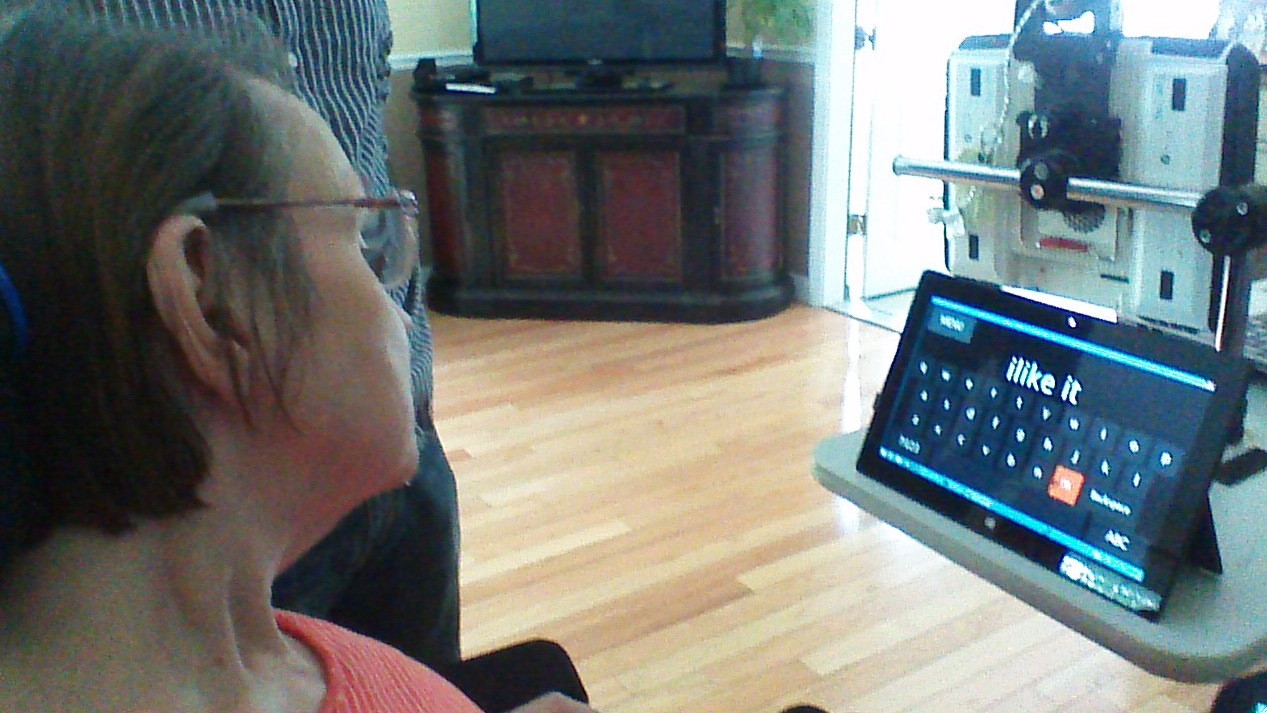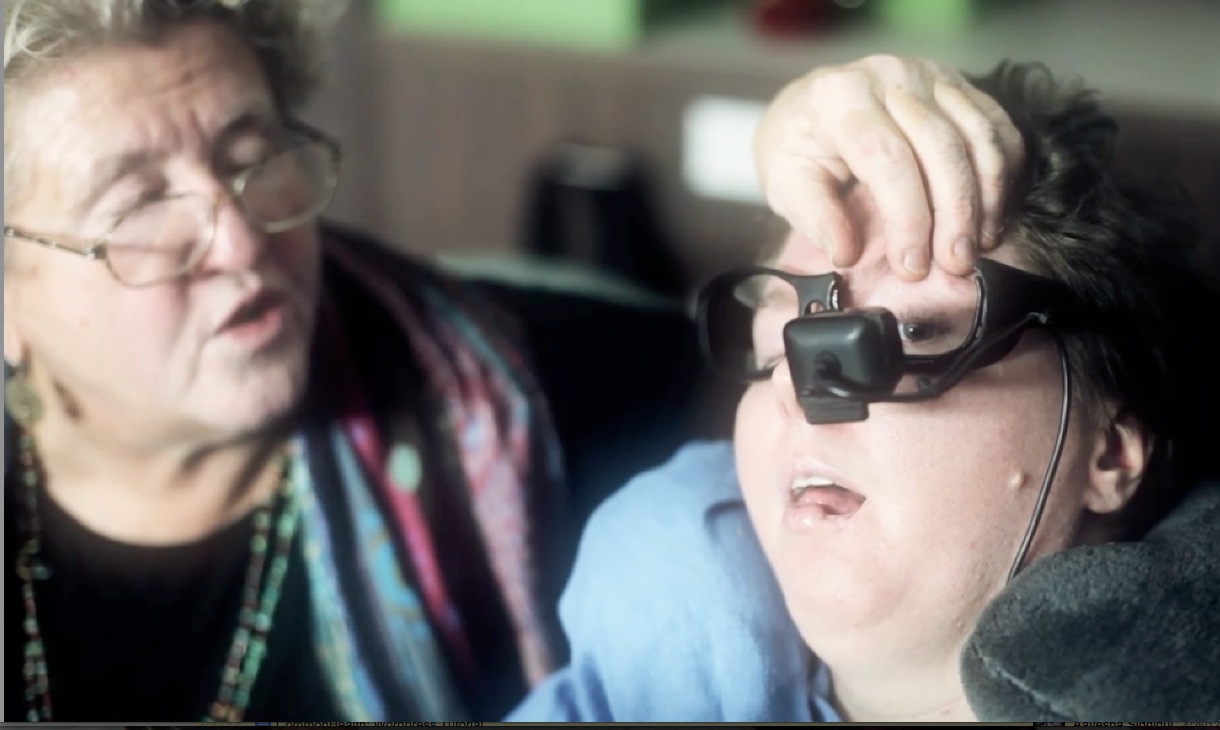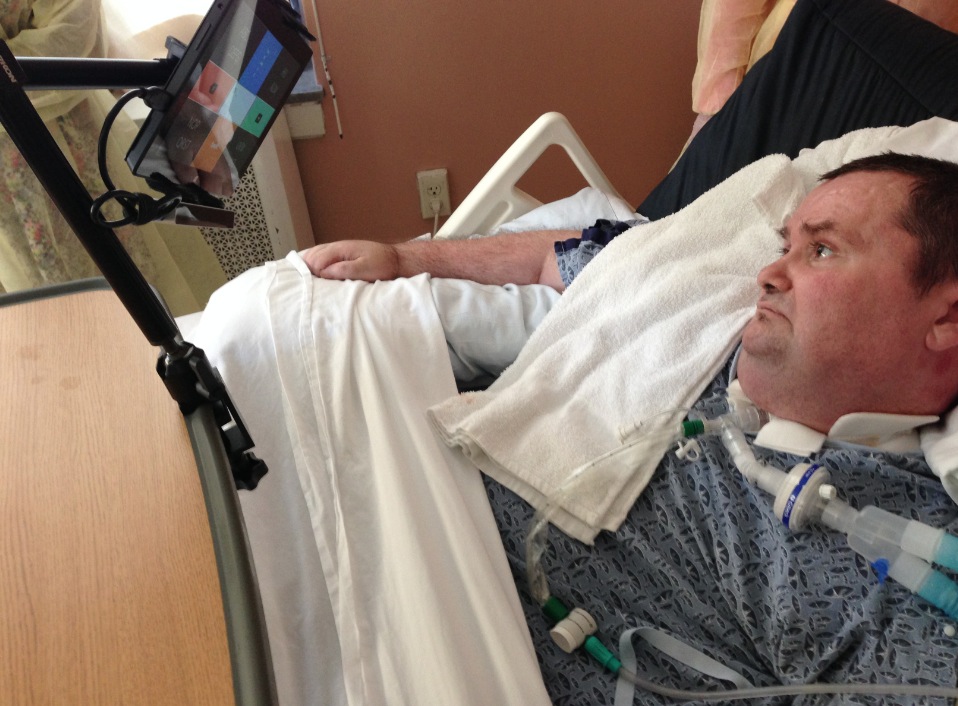Advertisement
Cheap, Low-Tech Devices Help Paralyzed Patients 'Speak Their Minds'

By Suzanne Jacobs
Guest contributor
When the man started quoting Shakespeare with his eyebrow, Dan Bacher knew he was on to something.
All it took was an off-the-shelf webcam, a green sticker and an app, and the stroke victim had regained his ability to communicate.
“Before that, what he would do is, someone would stand next to him and literally read through the alphabet, and then he would raise his eyebrow to pick a letter,” Bacher says. “He was fully dependent on someone else, and he couldn’t initiate conversation. Someone had to say, ‘Do you want to say something?’”
So Bacher, an engineer, and his colleagues put a green sticker the size of a pencil eraser on the man’s eyebrow and turned a webcam into a tracking system that could follow the green sticker and register a raised eyebrow as a mouse click. With a custom-made app, the man could then scroll through the alphabet and type on his own.
And then Shakespeare — part of a line from "Henry IV" that goes, "A good wit will make use of anything; I will turn diseases to commodity."
“It was just like one of those wow moments, where we realized, ‘Wow, what we’re doing here really is making a difference,’” Bacher recalls. The device was just a prototype, but Bacher said he hopes to have something permanent for the patient in the coming months.
Bacher is the founder and CEO of the SpeakYourMind Foundation, a nonprofit organization based in Providence, Rhode Island, that’s developing low-cost and easy-to-use communication devices for people with neurological disorders who are “locked in,” virtually unable to move.
Advertisement
So far, the organization has only worked with about 12 clients and is still experimenting with prototype devices, but ultimately, Bacher says, he wants to have products that are widely available. Already, he says, people have been contacting him from around the country asking for help.
SpeakYourMind is far from the cutting edge of research on "brain-computer interfaces," but that’s the point. Having worked in Brown University’s BrainGate Lab, one of the leading research centers for advanced brain-computer interface technology, Bacher knows all about the cutting edge, and that’s why he decided to start SpeakYourMind — to give people a simpler option, at least for now.
Brain-computer interface technology is still in its infancy, Bacher says, and the state-of-the-art eye tracking devices currently on the market aren’t always practical. They run around $15,000, and although they’re reimbursed by health insurance, the process of getting one can be arduous — visits to the neurologist and speech pathologist, lots of paperwork, having to try out different devices. Even when someone finally gets a device, he says, it’s not always smooth sailing. The devices are so complex that caregivers often can’t even set them up properly.
Bacher saw the reality of this situation after working with a number of BrainGate clinical trial participants who had tried these eye-tracking systems with little success.
“More often than not, they were collecting dust in the closet,” he says. “And so, being the engineer that I am, and pulling resources from other people around Brown, I said, ‘You know what? I’m pretty sure we can solve some of these problems using low-cost, off-the-shelf hardware and create software to really meet the need of the individual.'”

Back To First Principles
With SpeakYourMind, Bacher is taking the field back to “first principles,” he says. The idea is to find what little ability someone has, whether it’s raising an eyebrow, flexing a muscle or just moving his or her eyes, and to build a cheap and simple device that can transform that ability into a means of communication.
Alik Widge, an engineer and psychiatrist, does research with brain-computer interface technology in the Division of Neurotherapeutics at Massachusetts General Hospital. He says there’s still a ways to go before the most advanced devices are widely available, and he commends Bacher for being willing to go low-tech.
“I really think it’s an awesome project,” Widge says. “The truth about assistive technology and clinical technology in general is that there is no single best way to approach a problem. Speaking as an engineer, this is always the tradeoff that you have to do in planning out any research program — are you going to invest your time in making more advanced technology or are you going to look around for what’s on the shelf right now?”
It’s not that Bacher is against advanced devices. In fact, he says he’d recommend a state-of-the-art eye tracking device to a client if he thinks it’s the right fit, but until the devices reach the mass market, there needs to be another option.
“What we’ve learned is that for a lot of people, they don’t need all the bells and whistles. They want something simple and intuitive,” he says. “We think that simplicity and robustness more often than not will trump performance, and of course, when you factor in drastically reducing cost and being able to give much faster access to our clients, we think that’s a win.”

At The Make-A-Thon
This spring, SpeakYourMind co-hosted an assistive technology make-a-thon at Brown University with a student group called STEAM (Science, Technology, Engineering, Art, Mathematics).
The two-day event featured a ragtag crew of 20 or so students tucked away in the back corner of a warehouse-sized engineering lab at Brown. Some were graduate students, many were undergraduates, and a few were out-of-town high schoolers. The rest of campus was quiet — empty streets, dark hallways, the occasional student here or there putting in extra hours — but these young engineers were hard at work.
At 4 p.m. on day two, the students, divided into teams, would have to present what they had been working on all weekend (and in a few cases, all semester) to a panel of judges. The projects were all different, but they all had the same goal — to restore the ability to communicate autonomously to those who had lost it — and the same scrappy, low-tech approach as SpeakYourMind.
Bacher was bouncing between groups to check on their progress and offer advice. One team was reverse-engineering Facebook so someone who was locked in could use an eye-tracking device to click through the website with just his or her eyes. Another group was developing a custom e-mail service that people could use by simply hitting the space bar as things on the screen they wanted to click were highlighted. Yet another group designed a new wheel-like onscreen keyboard for eye trackers and another a program for writing music with eye trackers.
And then there was Owen and Valay. Owen Duke, a high school student from New Hampshire, heard about SpeakYourMind from his dad, who had heard Bacher give a lecture. Intrigued, Duke got in touch with Bacher and the two of them started brainstorming a device for one of the organization’s clients — a man in New Jersey who had a brain injury and could only communicate by controlling which way his arm fell when someone lifted it up and dropped it.
The man clearly had some muscle activity in his arm but not enough to lift it on his own, so the question was: what kind of device could allow him to communicate using that muscle without needing the help of others?
Duke had an idea: he would attach a muscle sensor to an ace bandage and wire it to a microcontroller, making a kind of custom wearable device that would wrap around the man’s arm and pick up on his flexing.
He brought the device to the make-a-thon, where he teamed up with Brown University graduate student Valay Shah. Shah was working on software that turned his laptop camera into a tracking system. Inspired by another client who could both flex his arm and move his face, Shah used the tracking system to follow a small green sticker he had on the tip of his finger. The two components together were a makeshift mouse — the green dot for navigation and the muscle sensor for clicking.
When it was time to present, the duo made their way in front of the judges, awkwardly moving in lockstep so as not to detach the sensor around Duke’s arm from the laptop in Shah’s hand. The device was a crude prototype, but it worked, and the judges loved it.
It was a perfect demonstration of what SpeakYourMind is all about: finding an easy way to meet the needs of an individual, not in 20 years, but today.
"Right now, we’re actually learning just as much from our clients as we hope they’re benefiting from what we’re creating," Bacher says. "A lot of what we’re doing now is we’re visiting our clients, and we’re testing. You know, we’re changing settings; we’re adding new features, and we’re testing things out."
The ultimate goal, he says, is to "go from prototype to product and really get these things out there, to try to maximize our impact and help as many people as possible."